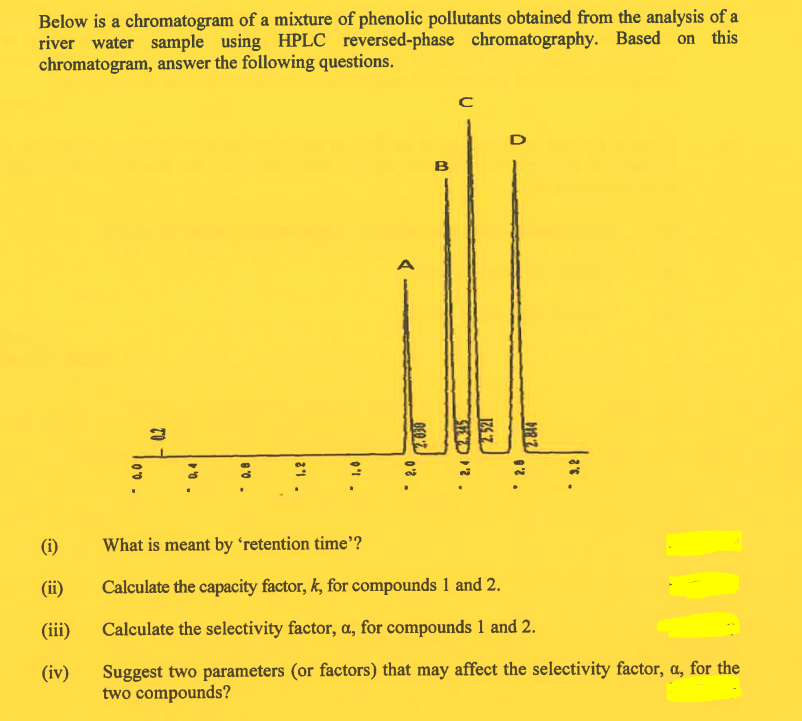Below is a chromatogram of a mixture of phenolic pollutants obtained from the analysis of a river water sample using HPLC reversed-phase chromatography. Based on this chromatogram, answer the following questions. (1) (ii) (iii) (iv) 0.01 TO 21. 1.0 2.030 - 2.0 B с 51712. 2.521 1187 02. 3.2 What is meant by 'retention time'? Calculate the capacity factor, k, for compounds 1 and 2. Calculate the selectivity factor, a, for compounds 1 and 2. Suggest two parameters (or factors) that may affect the selectivity factor, a, for the two compounds?
Below is a chromatogram of a mixture of phenolic pollutants obtained from the analysis of a river water sample using HPLC reversed-phase chromatography. Based on this chromatogram, answer the following questions. (1) (ii) (iii) (iv) 0.01 TO 21. 1.0 2.030 - 2.0 B с 51712. 2.521 1187 02. 3.2 What is meant by 'retention time'? Calculate the capacity factor, k, for compounds 1 and 2. Calculate the selectivity factor, a, for compounds 1 and 2. Suggest two parameters (or factors) that may affect the selectivity factor, a, for the two compounds?
Principles of Instrumental Analysis
7th Edition
ISBN:9781305577213
Author:Douglas A. Skoog, F. James Holler, Stanley R. Crouch
Publisher:Douglas A. Skoog, F. James Holler, Stanley R. Crouch
Chapter26: An Introduction To Chromatographic Separations
Section: Chapter Questions
Problem 26.14QAP
Related questions
Question

Transcribed Image Text:Below is a chromatogram of a mixture of phenolic pollutants obtained from the analysis of a
river water sample using HPLC reversed-phase chromatography. Based on this
chromatogram, answer the following questions.
(i)
(ii)
(iii)
(iv)
0.01
TO
0.8
1.2
0".
BEO
- 2.0
1757
$122.
2.8
3.2
What is meant by 'retention time'?
Calculate the capacity factor, k, for compounds 1 and 2.
Calculate the selectivity factor, a, for compounds 1 and 2.
Suggest two parameters (or factors) that may affect the selectivity factor, a, for the
two compounds?
Expert Solution
This question has been solved!
Explore an expertly crafted, step-by-step solution for a thorough understanding of key concepts.
Step by step
Solved in 3 steps

Knowledge Booster
Learn more about
Need a deep-dive on the concept behind this application? Look no further. Learn more about this topic, chemistry and related others by exploring similar questions and additional content below.Recommended textbooks for you

Principles of Instrumental Analysis
Chemistry
ISBN:
9781305577213
Author:
Douglas A. Skoog, F. James Holler, Stanley R. Crouch
Publisher:
Cengage Learning


EBK A SMALL SCALE APPROACH TO ORGANIC L
Chemistry
ISBN:
9781305446021
Author:
Lampman
Publisher:
CENGAGE LEARNING - CONSIGNMENT

Principles of Instrumental Analysis
Chemistry
ISBN:
9781305577213
Author:
Douglas A. Skoog, F. James Holler, Stanley R. Crouch
Publisher:
Cengage Learning


EBK A SMALL SCALE APPROACH TO ORGANIC L
Chemistry
ISBN:
9781305446021
Author:
Lampman
Publisher:
CENGAGE LEARNING - CONSIGNMENT